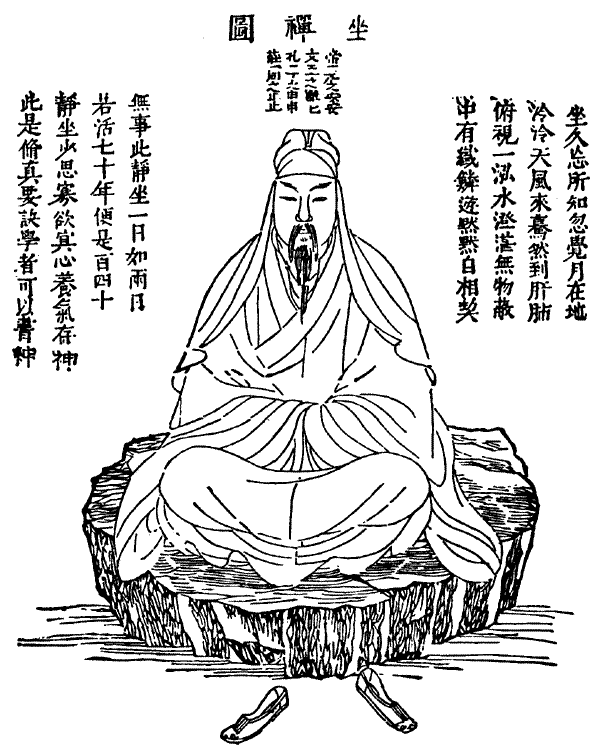
Buddhism and Eastern teaching
Encyclopedia

East Asia
East Asia or Eastern Asia is a subregion of Asia that can be defined in either geographical or cultural terms...
n religious traditions since it spread from India
India
India , officially the Republic of India , is a country in South Asia. It is the seventh-largest country by geographical area, the second-most populous country with over 1.2 billion people, and the most populous democracy in the world...
during the 2nd century AD.
Confucianism
ConfucianismConfucianism
Confucianism is a Chinese ethical and philosophical system developed from the teachings of the Chinese philosopher Confucius . Confucianism originated as an "ethical-sociopolitical teaching" during the Spring and Autumn Period, but later developed metaphysical and cosmological elements in the Han...
in particular raised fierce opposition to Buddhism in early history, principally because it perceived Buddhism to be a nihilistic
Nihilism
Nihilism is the philosophical doctrine suggesting the negation of one or more putatively meaningful aspects of life. Most commonly, nihilism is presented in the form of existential nihilism which argues that life is without objective meaning, purpose, or intrinsic value...
worldview, with a negative impact on society at large. The prominence of Confucianism in the Chinese society forced Buddhism to endorse certain uniquely Confucianist values. Over time as Buddhism became increasingly accepted by the Chinese intellectual class, relation between these two philosophies became more symbiotic. For example, Buddhism shares many commonalities with Neo-Confucianism
Neo-Confucianism
Neo-Confucianism is an ethical and metaphysical Chinese philosophy influenced by Confucianism, that was primarily developed during the Song Dynasty and Ming Dynasty, but which can be traced back to Han Yu and Li Ao in the Tang Dynasty....
, which is Confucianism with more religious elements.
Shinto
In the JapanJapan
Japan is an island nation in East Asia. Located in the Pacific Ocean, it lies to the east of the Sea of Japan, China, North Korea, South Korea and Russia, stretching from the Sea of Okhotsk in the north to the East China Sea and Taiwan in the south...
ese religion of Shinto
Shinto
or Shintoism, also kami-no-michi, is the indigenous spirituality of Japan and the Japanese people. It is a set of practices, to be carried out diligently, to establish a connection between present day Japan and its ancient past. Shinto practices were first recorded and codified in the written...
, the long coexistence of Buddhism and Shintoism resulted in the merging of Shintoism and Buddhism. Gods in Shintoism were given a position similar to that of Hindu gods in Buddhism. Moreover, because the Buddha Vairochana's symbol was the sun, many equated Amaterasu
Amaterasu
, or is apart of the Japanese myth cycle and also a major deity of the Shinto religion. She is the goddess of the sun, but also of the universe. the name Amaterasu derived from Amateru meaning "shining in heaven." The meaning of her whole name, Amaterasu-ōmikami, is "the great August kami who...
, the sun goddess, as his previous bodhisattva
Bodhisattva
In Buddhism, a bodhisattva is either an enlightened existence or an enlightenment-being or, given the variant Sanskrit spelling satva rather than sattva, "heroic-minded one for enlightenment ." The Pali term has sometimes been translated as "wisdom-being," although in modern publications, and...
reincarnation. The later Tokugawa Shogunate
Tokugawa shogunate
The Tokugawa shogunate, also known as the and the , was a feudal regime of Japan established by Tokugawa Ieyasu and ruled by the shoguns of the Tokugawa family. This period is known as the Edo period and gets its name from the capital city, Edo, which is now called Tokyo, after the name was...
era saw a revival of Shinto, and some Shinto scholars began to argue that Buddhas were previous incarnations of Shinto gods, reversing the traditional positions of the two religions. Shinto and Buddhism were officially separated during the Meiji Restoration
Meiji Restoration
The , also known as the Meiji Ishin, Revolution, Reform or Renewal, was a chain of events that restored imperial rule to Japan in 1868...
and the brief, but socially transformative rise of State Shinto
State Shinto
has been called the state religion of the Empire of Japan, although it did not exist as a single institution and no "Shintō" was ever declared a state religion...
followed. In post-war modern Japan, most families count themselves as being of both religions, despite the idea of "official separation".
Taoism
The relationships between TaoismTaoism
Taoism refers to a philosophical or religious tradition in which the basic concept is to establish harmony with the Tao , which is the mechanism of everything that exists...
and Buddhism are complex, as they influenced each other in many ways while often competing for influence. Taoism in its early form was a mixture of early mythology, folk religion, and Taoist philosophy. The arrival of Buddhism forced Taoism to renew and restructure itself into a more organized religion, while addressing similar existential questions raised by Buddhism. Early Buddhism was sometimes seen as a kind of foreign relative of Taoism and its scriptures were often translated into Chinese with Taoist vocabulary. Ch'an Buddhism in particular holds many beliefs in common with philosophical Taoism.

